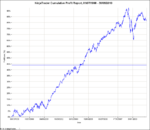Adamus
Experienced member
- Messages
- 1,898
- Likes
- 97
What to do with latest strategy with mixed results
First up, this strategy produced an unoptimised profit of $70K p.a. on a basket of 7 forex pairs.
The walk-forward though half-bombed: producing $2500 p.a. on the basket.
So question (1): is half-bombing as bad as full blow-out bomb curve-fit where the walk-forward results just lose the same amount as the optimisation won? i.e. do I chuck it out?
My unprofessional opinion is no, don't chuck it, it wasn't curve fit, it just didn't work in the walk-forward period because that is such a manic period. In fact, was it the whole period 01/07/2008 - present that was loss making, or was it in fact just 2008 and the first half of 2009?
Whatever, doesn't matter, I'll just try optimising this. I'm definitely not going to do anything with this strategy unoptimised, in case the currency markets revert back to their 2008/9 behaviour. That would eat up my little account like Ken Clarke devouring a canape at a Downing St reception.
NB the 2 optimisation parameters might not make much difference. I'll put some pretty equity curves up here later to show what happened.
First up, this strategy produced an unoptimised profit of $70K p.a. on a basket of 7 forex pairs.
The walk-forward though half-bombed: producing $2500 p.a. on the basket.
So question (1): is half-bombing as bad as full blow-out bomb curve-fit where the walk-forward results just lose the same amount as the optimisation won? i.e. do I chuck it out?
My unprofessional opinion is no, don't chuck it, it wasn't curve fit, it just didn't work in the walk-forward period because that is such a manic period. In fact, was it the whole period 01/07/2008 - present that was loss making, or was it in fact just 2008 and the first half of 2009?
Whatever, doesn't matter, I'll just try optimising this. I'm definitely not going to do anything with this strategy unoptimised, in case the currency markets revert back to their 2008/9 behaviour. That would eat up my little account like Ken Clarke devouring a canape at a Downing St reception.
NB the 2 optimisation parameters might not make much difference. I'll put some pretty equity curves up here later to show what happened.



